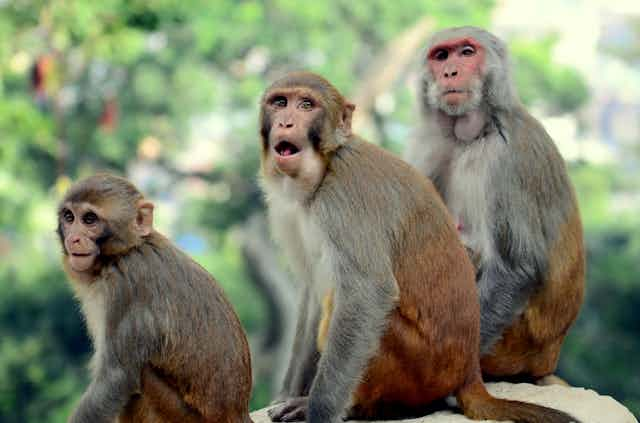The hosts of this year’s G20 summit in New Delhi, India, face a unique challenge: keeping monkeys from interfering with the event. The area’s rhesus macaques are bold and curious, but can be aggressive.
The municipal council’s strategy is to hire humans to imitate langur monkeys and scare off the macaques. The langur is traditionally believed to frighten macaques as they are supposedly “natural enemies”. It may work, but not for the reasons it’s supposed to.
And the use of professional monkey mimics hints at a much bigger issue: as our cities grow we will only experience more challenges interacting with nature.
On Delhi’s parliamentary estate, near where the summit is being held, macaques are known for stealing lunches and damaging property. They often bite. In the city of Shimla in the Himalayan foothills three to four people were bitten by macaques every day in 2014-2018.
It’s good news for G20 visitors, then, that New Delhi’s municipal council has plans to keep macaques at bay. India banned the use of langurs for this purpose in 2012 because of concerns about their welfare in captivity, where they were often kept chained.
Instead, for the G20 summit, 40 people have been hired as monkey mimics. Their job will include positioning life-size langur cut-outs around key parts of the city and imitating langur calls to scare off the local macaques.
Why might a monkey-mimic scare a macaque?
Two animals might be called natural enemies if they compete for the same foods, space or resources. But research shows this is unlikely to be the case for langurs and macaques.
Rhesus macaques are widely distributed from Afghanistan to China. They eat a highly varied diet that includes a lot of fruit, plus bark, seeds, buds and animal foods like fish, shellfish, eggs, honeycomb and insects.
Langurs are physically larger than rhesus macaques, so might win in a face-off, but are more narrowly distributed. Langurs mainly eat leaves but also consume some fruit, flowers and insects. Their reliance on leaves, however, means that in the wild they would not usually compete with macaques for food.
Macaques and their close relatives thrive in urban environments and rapidly adapt to dealing with people. For example, baboons in Cape Town mug people for groceries while Bali’s long-tailed macaques have learned to barter tourists’ stolen phones for food.
Langurs also seem to adapt less readily to urban areas than macaques, but can still be remarkably successful in cities. One group in Dakhineswar, for example, now consistently prefer bread to any plant.
Cities have so much food available that urban macaques and langurs probably don’t need to fight for resources. Their ecological differences in the wild also mean they probably don’t have a long-term history of competition.
This is backed up by evidence of peaceful, even friendly interactions between langurs and macaques in the wild. Juveniles sometimes play together. The adults are less friendly, but do not seem to object to one another’s presence. This is a far cry from what we’d expect reading about langurs’ supposed aggression towards macaques.
The heart of the problem
The ban on the capture of langurs is, in one way, a step forward for animal welfare. It’s good for conservation too as numbers of all seven langur species native to India are in decline. But this New Delhi approach may be bad for macaque welfare.
If langurs are not inherently scary to macaques, why do the authorities think that monkey-mimics’ calls and cut-outs will deter them? The most likely answer is that those calls and langur cut-outs are themselves intimidating.
New Delhi’s monkey mimics carry sticks. Their langur calls are described as “ear-piercing” screeches. Langur noises are already loud, and the mimics may make them louder to maximise their effect.
Taking the job seriously means working to cultivate fear so the effect doesn’t wear off. Being chased by a shouting, stick-wielding human is probably much scarier than seeing a langur. The cut-outs may be still and silent, but are associated with these scary humans, who macaques may see placing the cut-outs. These are probably intimidating as reminders of the monkey-mimics themselves.

Human-wildlife conflict is an almost inevitable consequence of human population growth and the expansion of urban areas. There are often negative effects for everyone.
Even if a macaque troop native to New Delhi was forced into urban life by human expansion, it’s not as if we can assume the humans had somewhere else to go. Urban expansion, poverty and inequality are connected in complicated ways, but people are now so numerous that we can’t just stop building cities.
Monkeys harassing visitors to a political summit may seem like a small problem but it’s interlinked with the major challenges of the 21st century: climate change, inequality, sustainability and globalisation.
There are no easy solutions to human-wildlife conflict. You could argue that the New Delhi case is positive because the people involved are looking for a way to manage a conflict that considers the impact on all the species involved.
It is not, however, a perfect approach. It’s a step in the right direction rather than a solution. Each idea that focuses on improving quality of life for both people and animals brings us closer to living together peacefully.

Don’t have time to read about climate change as much as you’d like?
Get a weekly roundup in your inbox instead. Every Wednesday, The Conversation’s environment editor writes Imagine, a short email that goes a little deeper into just one climate issue. Join the 20,000+ readers who’ve subscribed so far.

